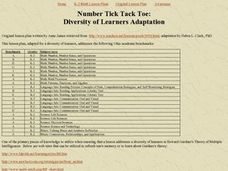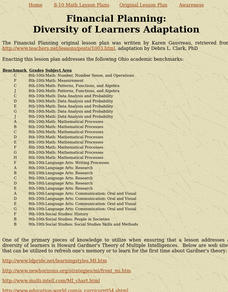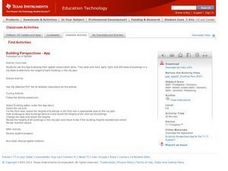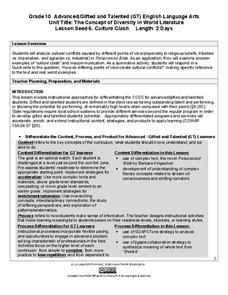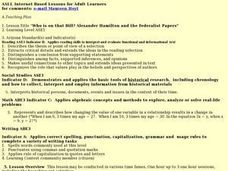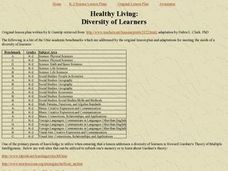Utah Education Network (UEN)
Know Your Literature Genres
Open the library for young readers by introducing them to the main genres and sub-genres. A podcast and two presentations identify the characteristics of the different genres. Groups then sort through a box of books and, using evidence...
Curated OER
Moving and Grooving with Tempo: Diversity of Learners Adaptation
Students with logical/mathematical intelligence keep count of the tempo of each song and of the number of different movements that they can create to go with the folk songs heard.
Curated OER
People, Places and Events
Students participate in the game People, Places, and Events to practice their science, and social studies skills
Curated OER
Faces of the community (the): Art from the Heart
Students understand the selflessness of the artists Gauguin and Van Gogh. For this art lesson, students produce art work that reflects the diversity in the their school community. Students share their artwork to explain how they show...
Curated OER
Number Tick Tack Toe
Students participate in activities that apply Howard Gardner's theory of Multiple Intelligences in order to improve literacy skills. The lesson is ideal for diverse learners because of the application of the theory.
Curated OER
Financial Planning
Students participate in activities in order to apply the skills of sound financial planning that includes creating and maintaining a budget. The lesson is intended for diverse learners because of the application of The Multiple...
Curated OER
Building Perspectives App
Learners explore a perspective application of the TI-73. In this middle school mathematics instructional activity, middle schoolers view the front, back, right, and left views of a city to determine the height of each building in a city...
Maryland Department of Education
The Concept of Diversity in World Literature Lesson 6: Culture Clash
To prepare for a Quickwrite on the question, "How do different points of view create cultural conflicts?" class groups draw examples of religious, cultural, and political conflicts from Things Fall Apart and The Poisonwood Bible to use...
Poets.org
Ghosts and Spirits
Connect poetry to a naturally kid-friendly topic: ghosts! Draw on your class's prior knowledge of the paranormal to help them access the classic poem "Haunted House" by Henry Wadsworth Longfellow. After a fun warm-up activity describing...
Curated OER
Who is on that Bill? Alexander Hamilton and the Federalist Papers
Students, who are adult learners, participate in an Internet scavenger hunt in order to assimilate information about the biography of Alexander Hamilton and the Federalist Papers. They look at the Federalist and Anti-Federalist Papers...
University of Chicago
Addressing Stereotypes
How is a stereotype defined, and what are some mechanisms we can use to combat negative stereotyping? Your young historians will discuss how and why stereotyping occurs, as well as consider the roots of modern conceptions of...
Curated OER
Express Yourself Lesson Seed 7: Pronouns
Take a break from literature study to address some grammatical concerns. Using a text you've already read in your class, show how to analyze pronoun use. After watching the master, pairs analyze a short excerpt on their own, identifying...
Curated OER
Justice Is Blind, Colorblind That Is
It's so interesting to see kids respond to articles about education. To start the day, prompt learners to discuss the words colorblindness and diversity. Then, split your class in two and have one side read an article from 2007 and...
Curated OER
Ocean Careers Exploration
Learners will work together in groups to gather information about careers in oceanography. They discover the need to have a diverse group of people on a team and then share their information with the class. Web links and materials are...
Curated OER
Healthy Living: Diversity of Learners
Students are drawn to those activities that are in line with their individual intelligences. They use classroom computers to find fruits and their names in other languages. Once a fruit is identified, students practice saying the name of...
Curated OER
Setting Up Camp
Draw on what learners know about conflict resolution and the situation in the Middle East to build understanding of the Camp David summit meeting beginning on July 11, 2000. They develop an understanding of the functions of summit...
Curated OER
Developing Dialogue
Why do people argue? Use the article "A Holiday Medley, Off Key" to discuss the struggles that interfaith couples face when choosing to celebrate certain holidays. Then, in small groups, encourage learners to write dialogues that...
Curated OER
Art and Artists: Diversity of Learners Adaptation
Learners determine the style of place cards as well as how to display phots of artwork. They organize and design an art museum for parents and other students to enjoy. Learners create place cards to explain the artwork, artist, as well...
National History Day
“War Is Hell. We Know it Now.” American Soldiers in the Meuse-Argonne Offensive
Understanding the soldier's experiences during World War I sometimes takes a newscast. Learners see the importance of understanding multiple points of view with a newscast project surrounding the Meuse-Argonne Offensive. Compare and...
Curated OER
Get Crafty! Integrate Art and Science
By combining diverse subjects, you will create some of your most memorable lessons.
Desert Discoveries
Amazing Arthropods
Arthropods are the stars of a fine science lesson. Learners look at the diversity, characteristics, adaptations, and important roles that these insects play in the Sonoran Desert environment. A terrific document called "Amazing...
Facing History and Ourselves
Preparing Students for Difficult Converstaitons
Many of the issues facing 21st Century learners are challenging and even discussing these issues can be a challenge. So how do teachers prepare learners for these difficult conversations? How do instructors create a safe classroom where...
Curated OER
Different! Diverse! Dynamic! What Do Stories Share?
Students compare and contrast the stories, "Leo, the Late Bloomer," and "Thank You, Mr. Falker." They develop a Venn diagram, and write and illustrate the central theme of the stories.
EngageNY
Close Reading of That Book Woman: How Did People Access Books in Rural Areas of the United States?
For this ninth lesson plan in a larger beginning-of-the-year unit, close reading skills are used independently to find the gist of the story That Book Woman. Rereading for important details is the targeted skill to unlock a deeper...




